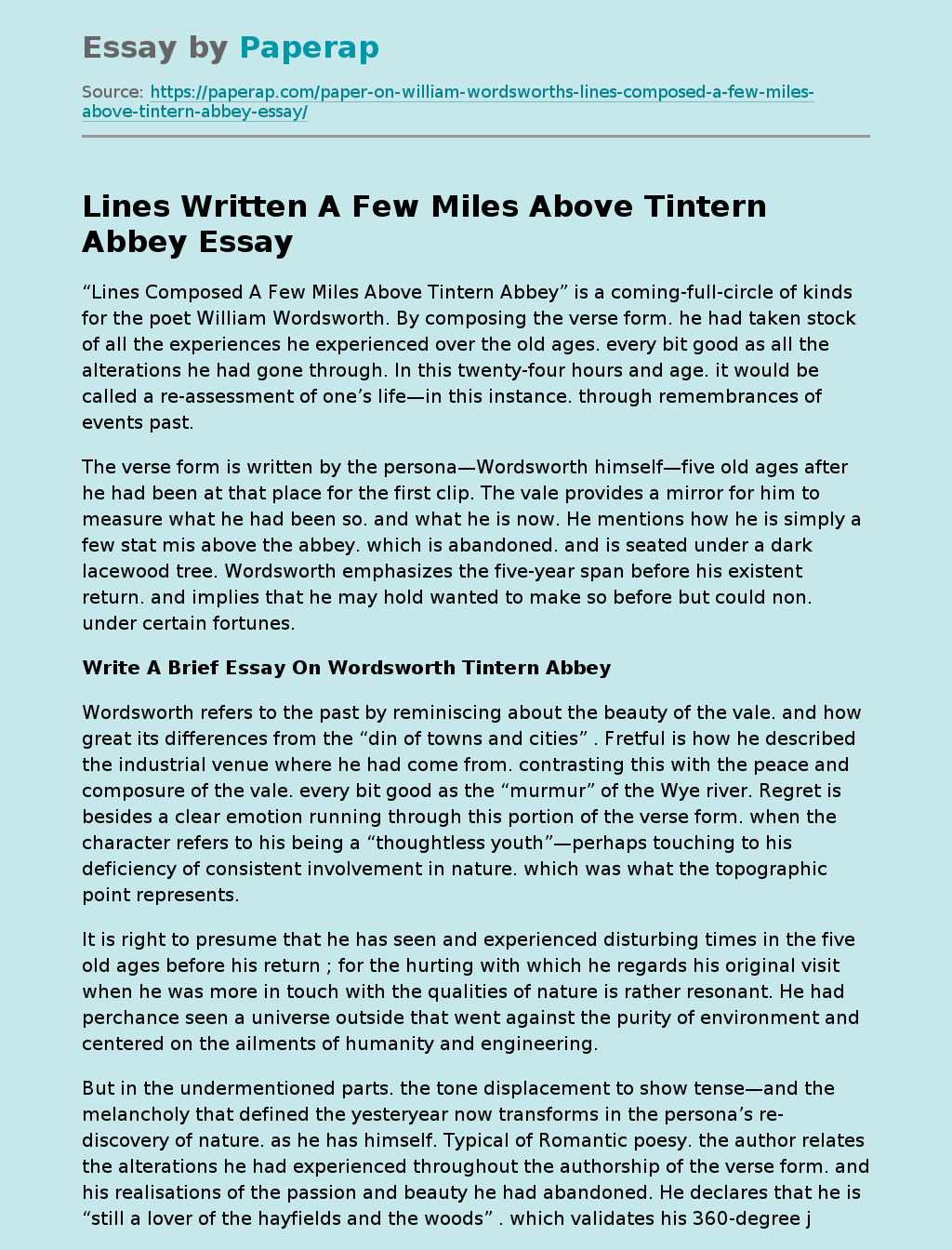Lines Written A Few Miles Above Tintern Abbey
Is a coming-full-circle of kinds for the poet William Wordsworth. By composing the verse form. he had taken stock of all the experiences he experienced over the old ages. every bit good as all the alterations he had gone through. In this twenty-four hours and age. it would be called a re-assessment of one’s life—in this instance. through remembrances of events past. The verse form is written by the persona—Wordsworth himself—five old ages after he had been at that place for the first clip.
The vale provides a mirror for him to measure what he had been so. and what he is now. He mentions how he is simply a few stat mis above the abbey. which is abandoned. and is seated under a dark lacewood tree. Wordsworth emphasizes the five-year span before his existent return. and implies that he may hold wanted to make so before but could non. under certain fortunes.
Wordsworth refers to the past by reminiscing about the beauty of the vale.
and how great its differences from the “din of towns and cities” . Fretful is how he described the industrial venue where he had come from. contrasting this with the peace and composure of the vale. every bit good as the “murmur” of the Wye river. Regret is besides a clear emotion running through this portion of the verse form. when the character refers to his being a “thoughtless youth”—perhaps touching to his deficiency of consistent involvement in nature. which was what the topographic point represents.
It is right to presume that he has seen and experienced disturbing times in the five old ages before his return ; for the hurting with which he regards his original visit when he was more in touch with the qualities of nature is rather resonant. He had perchance seen a universe outside that went against the purity of environment and centered on the ailments of humanity and engineering.
But in the undermentioned parts. the tone displacement to show tense—and the melancholy that defined the yesteryear now transforms in the persona’s re-discovery of nature. as he has himself. Typical of Romantic poesy. the author relates the alterations he had experienced throughout the authorship of the verse form. and his realisations of the passion and beauty he had abandoned. He declares that he is “still a lover of the hayfields and the woods” . which validates his 360-degree journey of self-contemplation. climaxing with his avowal that nature is so what he had missed. and what he prefers.
It is. in truth. a coming together of the ego and the object of desire—which is nature. The character had to delve up the events that had made him the individual he is now. and combined the lessons learned with what he has ever yearned to be. which is to be one with his darling vale. Yet it is non merely a determination made entirely by the character ; the fact that the “meadows and woods” still remain every bit beautiful as they were during the first visit shows the mutual credence of both ego and the object.
The following parts of the verse forms take on a future mention. which fits absolutely with the equation designed by Wordsworth. If the beginning contained regret. and the in-between portion expressed find. the logical stoping to the piece would decidedly be about hope. At this point. the character alludes to another individual. as he talks about his “former pleasances in the hiting visible radiations of thy wild eyes” . The existent individual Wordsworth may be mentioning to is his sister Dorothy. of whom he was fond and perchance portions many of Wordsworth’s ain sentiments. Dorothy. in this context. besides represents the reader. who is tasked to partake of the joyous find the character has gone through. and to hold faith in the fact that nature will ever supply peace and composure in life’s every turning point.
But as the lines are spoken. the general emotion once more displacements to despair. an imploring for Dorothy ( or the reader ) to retrieve the character at all times. He pleads with Dorothy to maintain nature in her bosom of Black Marias. which is really equivalent to inquiring her non to bury him—for nature. as related to Dorothy or the reader. now represents the character. or Wordsworth himself.
Possibly. to his head. he would wish to stay as fresh and alive as the hayfields and woods—something he would wish to be remembered by. The incompatibilities in memory are now evident. for the persona’s image of nature had non changed ; which is rather impossible. after the transition of five old ages. The thought of life and young person may be what the character wanted to retain. the image of it unstained and perfect in the heads of his sister. and of the reader.
The three parts and tenses of the poem represent Wordsworth’s rating of his ain life—from his vernal yesteryear. symbolized by the copiousness of nature ; his present province. already tarnished by experience and yearning for the artlessness of times gone by ; to what he believes could be in shop for him in the future—dry. wilting. and abandoned—lest person keeps his memory alive as he did nature.
Lines Written A Few Miles Above Tintern Abbey. (2019, Dec 05). Retrieved from https://paperap.com/paper-on-william-wordsworths-lines-composed-a-few-miles-above-tintern-abbey-essay/

